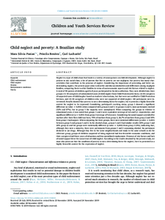Abstract
Neglect is a type of child abuse that leads to a variety of consequences on child development. Although neglect is present in any social class, a lot of parents that live in poverty are not negligent; but poverty has many characteristics that contribute to the presence of neglect. Considering the importance of preventing and better understanding neglect, the present paper aims to describe and discuss similarities and differences among negligent families, comparing them to other families in terms of socioeconomic aspects and risk factors related to neglect. A total of 90 parents of children aged 6–8 years participated in the data collection. They were divided into three groups: (1) 30 caregivers of substantiated cases of child neglect from Child Protection Services; (2) 30 caregivers of suspected cases of child neglect based on teachers’ observations, but that were not notified to Child Protection Services; and (3) 30 caregivers of children who were not suspected of child neglect. All participants were interviewed. Results showed that poverty is not a determining factor for neglect, but it presents a highly favorable context for neglect to be expressed. Considering participant’s working status, group 1 showed a significant difference (p-value = 0,003) when compared with groups 2 and 3. In groups 2 and 3, most participants worked (53% and 67%), but in group 1 the majority were unemployed. When comparing the groups in relation to educational years, it was noted that groups 1 and 2 were equivalent (average of 4,5 and 5,1 respectively), and significant different (p = 0,001) from group 3 (average of 9,4 years). Considering the social support provided for mothers after their first child was born, 70% of mothers from group 3, 26,7% of mothers from group 2 and 30% from group 1 had support. When comparing the three groups, there were statistical differences (p-valor = 0,001) between group 3 and groups 1 and 2. As for alcohol abuse, groups 1 and 2 had similar results (30% group 1 and 20% group 2) and the groups were statistically different (p-valor = 0,003) from group 3 (0%), indicating that, although they were a minority, there were participants from groups 1 and 2 consuming alcohol. No participant declared to use drugs. Although they live in the same neighborhoods and study in the same schools as do the reference group, groups of children suspected of being neglected had less favorable economic conditions, and their caregivers had fewer years of education and less specialized employment. Presence of risk factors and lack of social support favor the occurrence of child neglect. According to the results obtained by the present study, we must also point out that the condition of poverty is not a determining factor for neglect, but it is presented as a highly favorable context for the expression of neglect.
View article here.

